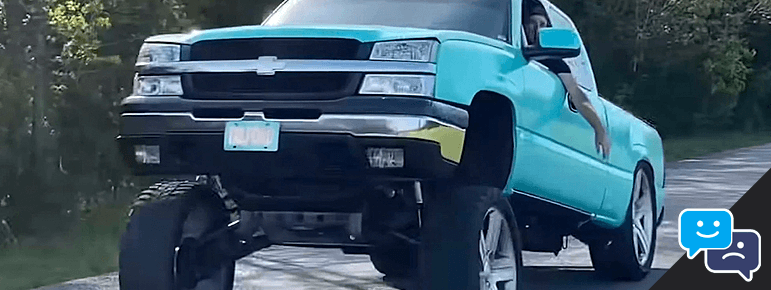If you’ve been following the latest trends in the trucking world, then you surely have heard about “squatted trucks”. These modified vehicles have been popping up everywhere and capturing the attention of truck enthusiasts and social media. But what exactly is a squatted truck?
A squatted truck is a modified pickup with a lowered rear end and raised front. It has a sloped appearance achieved by adjusting the suspension. While some find it visually appealing, it can compromise handling and safety by disrupting the truck’s intended design and engineering.
While it might look cool to some, it has sparked controversy and debates among truck enthusiasts, vehicle safety advocates, and lawmakers.
The one major concern is that squatted trucks pose a significant safety risk on roads. Because the suspension is imbalanced, with the center of gravity shifted to the rear. This makes squatted trucks more prone to rollovers and loss of control.
In this guide, we’ll delve deeper into the world of squatted trucks to understand what they are, how they came to be, and whether they are legal or not.
What Exactly Are Squatted Trucks?
A squatted truck, also known as a Carolina squat, Tennessee Tilt, Cali Lean, or Florida lean, is a truck with a lifted front end.
This is achieved by adding a lift kit to only the front suspension, and keeping the rear suspension at stock ride height. In some cases, owners lower the rear suspension to maximize the squatted appearance.
The goal of the modification is to create a slope from the front to the back of the truck, giving it a “tough” and aggressive appearance.
But the squatted truck modification trend doesn’t just stop at the front suspension. They also typically featured oversized tires, flashy rims, LED rock lights, and a loud exhaust.
How Long Have Squatted Trucks Been a Trend?
Squatted trucks have been around for several decades. In the past, they were mostly used by off-roaders who wanted to improve their trucks’ ground clearance for navigating tough terrains.
These vehicles were modified to raise the front for increased suspension travel and traction. Naturally, these lifts were done for performance reasons and not for aesthetics.
However, starting in the 1990’s, squatted trucks became popular among a subgroup of truck enthusiasts. They sought to make their vehicles stand out and look more aggressive.
But the modifications were done purely for cosmetic purposes. And often accompanied by giant wheels and tires, and other flashy accessories.
This trend has gained the most notoriety in the southern states. However, squatted trucks is most popular in Louisiana, Georgia, North and South Dakota.
Why Do People Drive Squatted Trucks?
It’s quite simple, many drivers perceive their vehicles as works of art and use them as a means to express their individuality through customization.
Rather than settling for a run-of-the-mill truck that resembles countless others straight from the assembly line, these drivers aim to make their vehicles truly distinctive.
As one can imagine, driving a squatted truck instantly grabs attention.
What Modifications Are Required to Squat a Truck?
Lifting only the front suspension is the most basic modification required to get that squat look. In most cases, truck owners lift their front suspension just a few inches to get that squat look.
But diehard squatters will take it to the next level, opting for an eight or even ten inch lift in the front and removing the factory suspension blocks in back.
To really get that true squat theme going, the addition of some fancy wheels and bigger, more beefy tires is a requirement.
As one can imagine, the modifications made to squatted trucks are not just limited to the suspension and wheels. Many truck owners also add decorative upgrades such as light bars, LED Underglow lighting, aftermarket grilles, and custom paint jobs.
However, these mods can come at a steep price, and many squatted truck owners have spent thousands of dollars getting the perfect look.
What Happens if You Squat Your Truck?
It can lead to poor handling, wear suspension parts faster, and reduce towing capacity. Truth be told, squatting your truck may seem cool, but it can cause problems.
Simply put, uneven weight distribution leads to an elevation in rolling resistance (commonly referred to as rolling friction), resulting in a decrease in engine efficiency.
As a result, improper weight distribution can cause disproportionate wear on tires and brake pads.
Why Are Some Lawmakers Against Squatted Trucks?
Despite the popularity of squatted trucks among truck enthusiasts, these modified vehicles have drawn controversy.
Lawmakers argue that due to their uneven weight distribution, squatted trucks can be hazardous on the road. The lack of balance can also cause issues with steering and braking, increasing the risk of accidents.
Because the suspension is imbalanced, with the center of gravity shifted to the rear, squatted trucks are more prone to rollovers and loss of control.
Additionally, the lowered rear end can impair the driver’s visibility, especially in rearview mirrors.
For example, squatted truck owners often face visibility challenges at night due to their headlights being angled upwards, rather than directed towards the road.
What States Are Squatted Trucks Illegal?
Of course the main issue that arises with driving a squatted truck is the potential for legal troubles. Depending on the state you live in, it may be illegal.
Currently, North Carolina, Virginia, and South Carolina have laws prohibiting squatted trucks. In fact, just recently South Carolina officials passed legislation that bans this vehicle modification as well.
A closer inspection of South Carolina’s bill states that a truck or SUV where the front fender is raised four or more inches above the height of the rear fender is illegal.
If pulled over, you may face fines, equipment violations, and difficulty passing state inspections.
As one can imagine, fans of squatted trucks aren’t happy with these bans and have created a petition.
How Are Trucks Owners Getting Around The Squatted Truck Ban?
To get around the state bans, owners are installing air suspension to the rear of the vehicle to level the squatted truck while driving. Then, when parked, airing down the rear to get that squatted look.
It’s a clever solution to staying legal while keeping the style of the squat when parked.
Squatted Trucks FAQs
Are Squatted Trucks Illegal in SC?
On May 16, 2023, Governor of South Carolina, Henry McMaster officially singed into law a ban on squatted trucks. The law states that the front of the truck cannot be raised more than 4 inches in height from the fender.
How Much Does it Cost to Squat a Truck?
The costs to squat a truck include installing a suspension lift kit, larger tires and wheels, labor, and additional modifications. Overall, the price can range from a few thousand to tens of thousands of dollar.
The cost of squatting a truck can vary widely depending on factors like the type of truck, desired modifications, and where the work is done.
How is a Squatted Truck Different From a Regular Truck?
Squatted trucks differ from regular trucks in that their front end is lifted higher than the rear.
Can Squatted Trucks be Lifted Back to Their Original Height?
Yes, you can lift a squatted truck back to their original height by modifying the front suspension system.
Do Squatted Trucks Affect The Overall Stability and Handling of The Vehicle?
Overall yes, as squatted trucks can negatively affect stability and handling. Weight distribution shifts, rear suspension compresses excessively, suspension geometry changes, front suspension travel is reduced, and the risk of overloading increases.
Are There Any Potential Legal Consequences For Driving a Squatted Truck?
Yes, driving a squatted truck can lead to legal consequences such as traffic violations, equipment violations, registration and inspection issues, insurance problems, and civil liability.
Generally, lifting the front of the truck 4 inches or higher can result in fines, and potential lawsuits for accidents or property damage.
Are Squatted Trucks Only Used For Aesthetic Purposes, or do They Serve Any Functional Benefits?
Squatting a truck is mainly for looks, but some argue they improve towing and ground clearance for off-road driving.
What Are The Most Popular Trucks to Squat?
While any truck or SUV can be squatted, the most popular trucks for this trend include: GMC Sierra, Toyota Tundra, Ford F-150, Dodge Dakota, Chevrolet Silverado (Cat eye), Toyota Tacoma, Ford Ranger, and Ram 1500.
Final Thoughts
Squatted trucks are a cultural phenomenon that’s emerged from the intersection of automotive engineering, pop culture, and social identity.
While some find them appealing as a form of self-expression and creativity, others denounce them as dangerous and illegal modifications that flaunt traffic laws and endanger other drivers.
Ultimately, whether squatted trucks are legal depends on the state and jurisdiction where they are driven.
However, it’s essential to consider the safety consequences and social perceptions before modifying trucks for aesthetic purposes.

Managing Editor
Christopher is an automotive technical writer. When he’s not at the local autocross event, he can often be found working on one of his cars. Specializes in automotive class action law, industry trends, and automotive maintenance. Email me direct, or learn more about us

